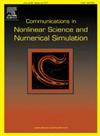Bilateral consistency and vibration control for nonlinear flexible Timoshenko robotic arms in signed directed communication graph with quantized control inputs
IF 3.8
2区 数学
Q1 MATHEMATICS, APPLIED
Communications in Nonlinear Science and Numerical Simulation
Pub Date : 2025-09-19
DOI:10.1016/j.cnsns.2025.109334
引用次数: 0
Abstract
In this paper, bilateral consistency and vibration control are addressed for a multi-agent system comprising flexible Timoshenko robotic arms, operating under a signed directed communication topology. Each flexible manipulator is characterized as a distributed parameter system, with the corresponding models encompassing governing equations formulated through partial differential equations (PDEs) and boundary conditions described by ordinary differential equations (ODEs). Additionally, to efficiently utilize storage space and transmission channel bandwidth, the study delves into signal quantization, and it employs logarithmic quantizers for processing the input signals. By implementing the proposed control scheme on the nonlinear flexible Timoshenko robotic arm multi-agent system, bilateral consistency in joint angles can be achieved, and the simultaneous suppression of both bending deflection and shear deflection can be realized. Ultimately, simulation results are presented to demonstrate the efficacy of the control strategy.
带有量化控制输入的非线性柔性Timoshenko机械臂的双向一致性与振动控制
本文研究了一个由柔性Timoshenko机械臂组成的多智能体系统的双边一致性和振动控制问题,该系统在签名定向通信拓扑下工作。每个柔性机械臂都被表征为一个分布参数系统,相应的模型包括由偏微分方程(PDEs)表示的控制方程和由常微分方程(ODEs)描述的边界条件。此外,为了有效利用存储空间和传输信道带宽,本研究深入研究了信号量化,采用对数量化器对输入信号进行处理。通过对非线性柔性Timoshenko机械臂多智能体系统实施所提出的控制方案,可以实现关节角度的双边一致性,同时抑制弯曲挠度和剪切挠度。最后给出了仿真结果,验证了控制策略的有效性。
本文章由计算机程序翻译,如有差异,请以英文原文为准。
求助全文
约1分钟内获得全文
求助全文
来源期刊

Communications in Nonlinear Science and Numerical Simulation
MATHEMATICS, APPLIED-MATHEMATICS, INTERDISCIPLINARY APPLICATIONS
CiteScore
6.80
自引率
7.70%
发文量
378
审稿时长
78 days
期刊介绍:
The journal publishes original research findings on experimental observation, mathematical modeling, theoretical analysis and numerical simulation, for more accurate description, better prediction or novel application, of nonlinear phenomena in science and engineering. It offers a venue for researchers to make rapid exchange of ideas and techniques in nonlinear science and complexity.
The submission of manuscripts with cross-disciplinary approaches in nonlinear science and complexity is particularly encouraged.
Topics of interest:
Nonlinear differential or delay equations, Lie group analysis and asymptotic methods, Discontinuous systems, Fractals, Fractional calculus and dynamics, Nonlinear effects in quantum mechanics, Nonlinear stochastic processes, Experimental nonlinear science, Time-series and signal analysis, Computational methods and simulations in nonlinear science and engineering, Control of dynamical systems, Synchronization, Lyapunov analysis, High-dimensional chaos and turbulence, Chaos in Hamiltonian systems, Integrable systems and solitons, Collective behavior in many-body systems, Biological physics and networks, Nonlinear mechanical systems, Complex systems and complexity.
No length limitation for contributions is set, but only concisely written manuscripts are published. Brief papers are published on the basis of Rapid Communications. Discussions of previously published papers are welcome.
 求助内容:
求助内容: 应助结果提醒方式:
应助结果提醒方式:


